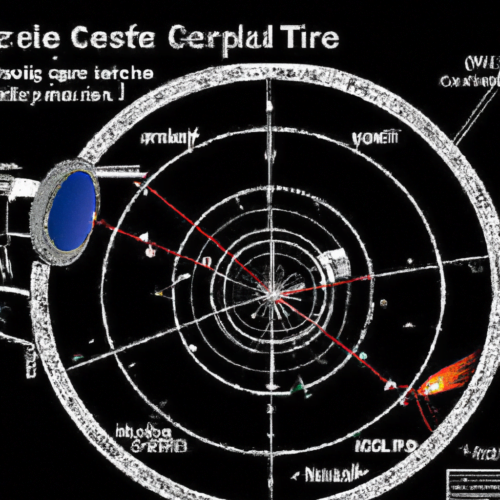Have you ever wondered how astronomers are able to pinpoint celestial objects in the vast expanse of space? Well, that’s where Digital Setting Circles (DSC) in telescopes come into play. In simple terms, DSC is a revolutionary technology that assists astronomers in accurately locating and tracking objects in the night sky. By utilizing a digital display and an integrated computer system, DSC provides real-time information about the precise coordinates and movements of celestial objects. With this handy tool, stargazers can embark on an incredible journey through the wonders of the universe, unlocking the secrets of distant galaxies and nebulae. So, let’s dive into the fascinating world of DSC and explore its profound impact on the realm of astronomy.
Table of Contents
Overview of Digital Setting Circle (DSC)
Definition of DSC
A Digital Setting Circle (DSC) is a device that provides real-time digital readings of celestial coordinates to assist astronomers and stargazers in locating and tracking celestial objects. It is a technological advancement over traditional setting circles, which rely on manual calculations and readings to determine the position of celestial objects in the sky.
History and development of DSC
The development of Digital Setting Circles can be traced back to the 1990s when computerized telescopes started gaining popularity. As computer technology advanced, astronomers sought to integrate this technology into telescopes to simplify the process of locating and tracking celestial objects. Over the years, DSCs have undergone significant improvements and are now widely used in amateur and professional telescopes.
Why DSC is important in telescopes
Digital Setting Circles play a crucial role in telescopes as they enhance accuracy and efficiency in locating celestial objects. By providing precise readings of celestial coordinates, DSCs eliminate the need for manual calculations and chart referencing, saving time and effort. Additionally, DSCs make it easier for beginners to navigate the night sky and helps experienced astronomers track specific objects with greater precision.
How Digital Setting Circle Works
Components of a DSC
A Digital Setting Circle comprises several key components working together to provide accurate celestial coordinates. It includes an electronic display, a microcontroller, encoders or sensors, and a connection interface. The encoders or sensors measure the telescope’s altitude and azimuth, while the microcontroller processes this data and displays the corresponding celestial coordinates on the electronic display.
Connection to telescope
Digital Setting Circles are designed to be compatible with a wide range of telescopes. They are usually connected to the mount of the telescope, and the encoders or sensors are positioned to measure the movements of the telescope. The connection can vary depending on the specific DSC model, but most commonly involves attaching the encoders or sensors to the telescope’s mount or axes.
Operation and functionality of DSC
Once connected, the Digital Setting Circle is powered on, and the user selects the desired celestial object from a preloaded database or manually enters the coordinates. The DSC then calculates the telescope’s position and provides real-time readings through the electronic display. As the telescope moves, the DSC continuously updates the readings to guide the user in tracking the selected object accurately.

Benefits of Using Digital Setting Circle
Increased accuracy in object tracking
One of the significant advantages of a Digital Setting Circle is the increased accuracy it offers in object tracking. By providing real-time celestial coordinates, DSCs eliminate the potential for human error in manual calculations and readings. This improved accuracy allows users to precisely align their telescopes with the desired celestial objects, enhancing the overall stargazing experience.
Efficiency and time-saving
Using a Digital Setting Circle can streamline the process of locating celestial objects, making it more efficient and time-saving. The digital readings provided by the DSC eliminate the need for manual calculations and chart referencing, saving valuable time that can be spent observing the night sky. This efficiency is particularly beneficial for observing time-sensitive events, such as meteor showers or eclipses.
User-friendly interface
Digital Setting Circles are designed with user-friendliness in mind. They often feature intuitive interfaces and menu systems, making them accessible even to beginners. The clear and concise display of celestial coordinates simplifies the process of tracking objects, allowing users to focus on the wonders of the night sky rather than complex calculations.
Choosing a Digital Setting Circle
Considerations for selecting a DSC
When choosing a Digital Setting Circle, there are several factors to consider. Firstly, it is important to determine the specific requirements and goals of your stargazing or astronomical pursuits. Consider the desired level of accuracy, compatibility with other equipment, and any additional features that may be beneficial.
Compatibility with telescopes
Digital Setting Circles are available in various models and designs, each catering to different types of telescopes. It is crucial to ensure compatibility between the DSC and your telescope before making a purchase. Consult the manufacturer’s specifications and compatibility charts to determine if the DSC is suitable for your telescope model.
Cost and budget considerations
The cost of Digital Setting Circles can vary significantly based on their features, brand, and quality. It is important to set a budget and consider the cost in relation to the features and benefits offered by each DSC. Consider investing in a reliable DSC that meets your requirements while working within your budget.

Installing a Digital Setting Circle on Your Telescope
Step-by-step installation guide
Installing a Digital Setting Circle on your telescope is a relatively straightforward process. Begin by carefully reading the manufacturer’s instructions provided with the DSC. Typically, it involves attaching the encoders or sensors to the telescope mount and connecting the cables to the DSC device. Follow the step-by-step instructions provided by the manufacturer to ensure a proper and secure installation.
Calibration and alignment process
After the physical installation, it is essential to calibrate and align the Digital Setting Circle to ensure accurate readings. Calibration involves setting the initial readings of the DSC to align with known celestial objects. Alignment fine-tunes the readings based on the telescope’s specific movements. Consult the manufacturer’s instructions for the recommended calibration and alignment procedures for your DSC model.
Troubleshooting common installation issues
During the installation process, it is possible to encounter common issues such as misalignment or connectivity problems. If you encounter any difficulties, refer to the troubleshooting section of the manufacturer’s instructions or contact their customer support for assistance. It is important to address any installation issues promptly to ensure optimal performance of the DSC.
Tips and Tricks for Using a Digital Setting Circle
Proper maintenance and care
To ensure the longevity and optimal performance of your Digital Setting Circle, it is essential to practice proper maintenance and care. Keep the device clean and free from dust or debris, and avoid exposing it to extreme temperatures or moisture. Regularly check and tighten any connections to prevent loosening over time.
Advanced features and customization options
Digital Setting Circles often come equipped with advanced features and customization options. Explore the user manual and manufacturer’s documentation to fully utilize these additional functionalities. Customizing the display layout, adjusting settings, and utilizing advanced tracking capabilities can enhance your stargazing experience and help you discover celestial objects more efficiently.
Integration with astronomy apps and software
Many Digital Setting Circles offer compatibility with astronomy apps and software, further expanding their capabilities. Take advantage of these integrations by connecting your DSC to popular astronomy apps or software packages. This allows you to access broader databases of celestial objects, receive real-time updates, and even control your telescope remotely.

Alternative Technologies to Digital Setting Circle
Traditional setting circles
Traditional setting circles rely on mechanical dials and charts to determine celestial coordinates. While they provide a basic level of guidance for locating objects, they require manual calculations and can be prone to human error. The use of traditional setting circles requires a familiarity with celestial coordinate systems and additional time spent referencing charts.
GOTO systems
GOTO (Go To) systems, commonly found in computerized telescopes, offer an automated solution for locating celestial objects. By inputting the desired object or selecting it from a database, the GOTO system moves the telescope to the correct coordinates automatically. GOTO systems incorporate DSC technology to provide accurate and precise object tracking.
Mobile applications
With the advancements in smartphone technology, mobile applications have become a popular alternative to traditional setting circles and even DSCs. These apps utilize the device’s GPS, accelerometer, and compass features to provide real-time readings and object tracking functionalities. Mobile applications offer convenience and accessibility, particularly for casual stargazers or beginners.
Frequently Asked Questions about Digital Setting Circle
What telescopes are compatible with DSC?
Digital Setting Circles are designed to be compatible with a wide range of telescopes. However, it is important to check the specifications and compatibility charts provided by the manufacturer to ensure compatibility with your specific telescope model.
Can DSC be retrofitted to older telescopes?
In many cases, Digital Setting Circles can be retrofitted to older telescopes. Retrofitting may involve additional hardware or modifications to the telescope’s mount or axes. It is recommended to consult with the manufacturer or an experienced astronomer for guidance on retrofitting a DSC to an older telescope.
Are there wireless options available for DSC?
Yes, there are wireless options available for Digital Setting Circles, allowing for greater freedom and convenience in using the device. Wireless DSCs eliminate the need for physical connections or cables and enable remote control and operation through compatible devices or applications.

Conclusion
Digital Setting Circles have revolutionized the way astronomers and stargazers locate and track celestial objects. Through their enhanced accuracy, efficiency, and user-friendly interfaces, DSCs have made the wonders of the night sky more accessible to amateurs and professionals alike. By understanding the workings of DSCs, considering key factors in selection, and following proper installation procedures, enthusiasts can embark on a fascinating journey of exploration and discovery in the celestial realm.
